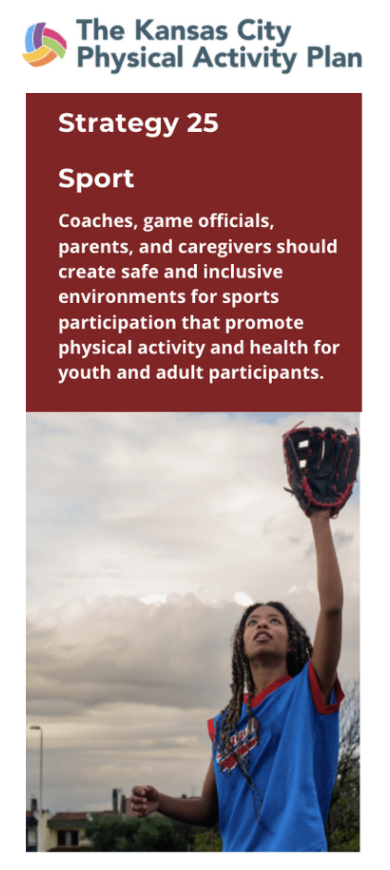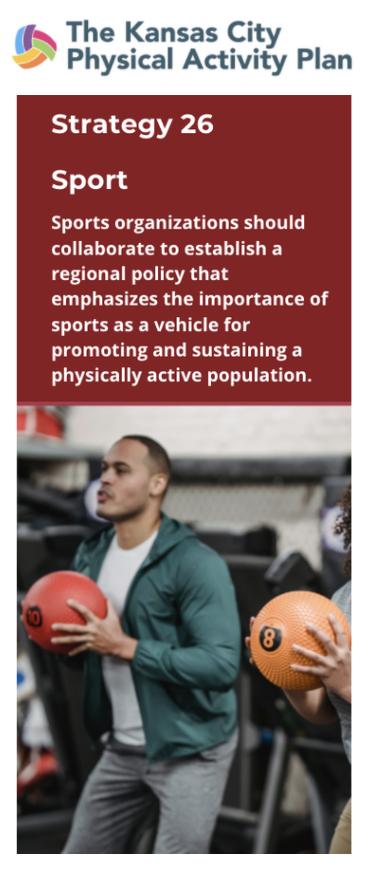To join the Sport Sector, please type your email in the subscription bar provided below.
The Sport Sector is co-led by Peter Piscitello, from Play Like a Champion, and Bill Brandmeyer from Sharewaves, Inc.
Workshop Summary
Have a question?
Feel free to contact us!
KCPA Plan Strategies and Tactics for Sport
As stated in the National Physical Activity Plan, sports represent a ‘powerful opportunity to make transformative progress in youth and adult physical activity and health in the United States.’
More than 200 million youth and adults participate in some form of sports including traditional organized sports to casual and unstructured play, representing an important source of regular physical activity. In our region, 60.1% of children and youth played on at least one sports team in the past year (KC Physical Activity Report Card for Children and Youth, 2020). Sports also provide many benefits beyond health, including advancing health equity, supporting child development, accelerating inclusion, stimulating economic growth, and making important cultural contributions.
The current sports experience is not the same for all. Some youth find multiple barriers related to participation, while others are inactive during practice. Some become injured during sports while others have negative experiences. Some do not have safe places for free or unstructured play, while others simply have no opportunities for participation. These disparities in the sports experience have only been exacerbated during the COVID-19 pandemic, with sports participation (including competition, practices, and free play) decreasing by 2.5 hours/week for families earning less than $99,000/year while increasing 1.2 hours/week for families earning more than $100,000/year compared to pre-pandemic levels (Aspen Institute, COVID-19 Parenting Survey III, April 2021).
For these reasons, the Kansas City Physical Activity Plan is of key importance. The strategies and tactics developed in this sector represent a multi-level approach to creating safe and equitable access to sport participation, including policy change, building capacity, adding infrastructure, elevated surveillance, improving safety, and more knowledgeable coaches, parents and caregivers, and sport participants.
Strategy 23
Leaders in multiple sectors should expand access to recreational spaces and quality sports programming while focusing on eliminating disparities in access based on race, ethnicity, gender, disability, socioeconomic status, geography, age, and sexual orientation.
Tactics
Use data to identify populations who are at risk of physical inactivity, understand their specific barriers, and devise targeted initiatives to reduce disparities.
Prioritize community-based, affordable forms of organized play, such as in-town leagues. Continue offering these formats into and beyond adolescence.
Create opportunities for free and loosely supervised play.
Incorporate sports activities into before- and after-school programming.
Strategy 24
Sports organizations should adopt policies and practices that promote overall health, physical health, and mental health, as well as participant growth, and development of physical literacy.
Tactics
Increase awareness about the need for parents and caregivers (and others who can properly advocate for children other than their own) to encourage sport sampling, where youth play multiple sports throughout the year, including formal (sports leagues) and informal (pick-up games) sports to ensure increased levels of physical activity. Allow youth to self-select their sport(s) of choice as they get older and have experienced a variety of sports.
Support parents and caregivers in efforts to demand that all youth sports facilities and equipment are safe and that leagues adopt and follow the guidelines established by the United States Olympic Committee’s SafeSport program (SafeSport.org). Require that all coaches be required to take the SafeSport training course.
Develop and promote educational resources outlining important factors related to parental and caregiver behavior that affects the development of youth athletes, including information about creating a positive environment with a focus on fun and discovery, being a good role model, and other topics, such as goal setting, good sportsmanship, and importance of sustained physical activity levels.
Align coaching accreditations and curricula with best practices.
Use mandates and incentives to increase the number of coaches trained in key competencies, including basic safety and immediate care, plus sport-specific rules.
Strategy 25
Coaches, game officials, parents, and caregivers should create safe and inclusive environments for sports participation that promote physical activity and health for youth and adult participants.
Tactics
Identify and reward sport organizations that foster sports models that are inclusive of groups that are underserved by traditional sports programs.
Establish pricing models and sport season timelines that encourage multi-sport participation.
Identify and disseminate evidence-based practices that prioritize moderate- to vigorous-intensity physical activity for all participants during practices and games.
Embrace developmentally appropriate forms of play, through frameworks such as the U.S. Olympic Committee’s American Development Model. (SP-4.4)
Strategy 26
Sports organizations should collaborate to establish a regional policy that emphasizes the importance of sports as a vehicle for promoting and sustaining a physically active population.
Tactics
Engage public agencies and private organizations from multiple sectors in development of a regional policy on sport.
Build support for development of a regional policy on sport by increasing awareness of the importance of such a policy among key stakeholders
Identify an organization, either public or private, that will “house” a regional policy on sport.
Strategy 27
Sports organizations should establish a regional entity that can serve as a central resource to unify and strengthen stakeholders in the sports sector.
Tactics
Build awareness, among sport organizations, of the value of “backbone” entities which leverage and coordinate resources across affiliated organizations.
Develop a funding mechanism for an entity that serves as a central resource for stakeholders in the sport sector.
Engage sport organizations that currently play a coordinating role (e.g., the U.S. Olympic Committee) in the process of developing an entity that provides broad leadership for the sport sector.
Strategy 28
Sports organizations should ensure that sports programs are conducted in a manner that minimizes risk of sports-related injuries and illnesses.
Tactics
Establish policies and practices that ensure sports programs put the highest priority on the health and safety of participants.
Educate parents, athletes, coaches, teachers, and others about the signs and symptoms of sports injuries and conditions (e.g., brain injury, heat illness, and exertional sickling).
Encourage the importance of collaboration with medical professionals to ensure safe outcomes during play.
Ensure that sports equipment, uniforms, playing surfaces, and environmental conditions are checked for safety and best conditions.
Strategy 29
Public health agencies, in collaboration with sports organizations, should develop and implement a comprehensive surveillance system for monitoring sports participation in all segments of the population.
Tactics
Develop and implement a roadmap that will lead to the establishment of a comprehensive National Surveillance Collaborative for Sports, Physical Activity, and Health in the United States for all populations. The aim of the Collaborative will be to expand the use of data made available to, translated for, and used by all stakeholders to design and improve sports programs at all levels.
Create a regional survey tool that measures the overall experience of participants.
Strategy 30
Sports organizations should use advances in technology to enhance the quality of the sport experience for participants.
Tactics
Leverage emerging technologies – in collaboration with recreational, competitive, and elite sport organizations – to connect all people with the full array of sports and recreation options in their geographic communities for people of all abilities and levels of physical activity.
Make advances in sports technology more widely known and available to all.
Use technological resources to identify or create tools and apps that can produce customizable surveys for teams and leagues to use to better understand the sport experience of their participants.
Use technological innovation to promote physical activity to spectators and fans of sports at events.
Create a national coordinating network of leaders and hubs focused on promoting existing and future technological innovation that can increase participation in quality sports programs and enhance the quality of the sport experience for participants.











